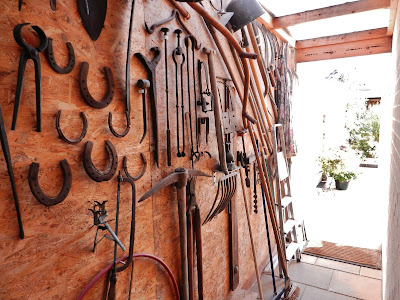Steve managed to get the day off work on Thursday so we went to the Forest of Dean in Gloucestershire.
I am unreasonably in love with that name. It sounds like something out of Monty Python, don't you think?
Forest of Dean.
Forest of Dean.
Anyway, we drove around the Cotswolds first, because the area is just a few minutes away from Jan and Steve's house and they thought it was worth a visit.
It wasn't too long before I discovered that my camera hadn't charged up overnight. Something to do with husband unplugging the laptop in which it was charging.
Harrumph!
Steve kindly let me use his camera.
Thatched roofs have been enjoying a resurgence in the UK and there are around 1,000 full-time thatchers at work in the country. A good quality thatched roof will last for 45 to 50 years.
Jan had been telling us about the signature figures left on the rooftop by some thatchers and, sure enough, here is a shining example.

Ducks in a row, made of thatch.
And an owl.
It's interesting to drive around the countryside in England and see how the building stone differs from one area to another. The stone in the Littletons has a lot of grey tones in it.
Here's something I'll bet you've never seen before.
Staddle stones.
The stone mushroom-y things that the barn is sitting on.
They were used as early as the 1700's as a supporting base for granaries, hayricks, game larders, etc. The shape of the stones protected the structures from vermin and water seepage. I think I need some of these stone beauties for my shed, which suffers sorely from both in our wet winters.
The Forest of Dean is the second largest Crown forest, meaning that it was designated a hunting area for monarchs. The practice was instigated in the 11th Century by the Normans. Remember William the Conqueror?
I don't think that royalty dare hunt here any more.
Wild boar reside here, but we didn't see any.
Lucky for the boar.
The first order of business was a picnic lunch.
You know it was!
I got a kick out of this couple making themselves comfortable in the sunny clearing.
I love trees, so indulge me for a moment.
Ah, wasn't that nice?
Did I mention that it was a perfectly sunny day?Here are Jan and Steve, consulting the map for the Sculpture Trail, on which we were about to embark.
Aren't they cute? I love their matching boots.
Jeff and I have never had matching boots.
Never ever.
But we do have a couple of matching fleece jackets.
The sculpture Trail is four miles long. We took our time, scrutinizing the sculptures and offering our constructive criticism when necessary.
As in, That's stupid, it doesn't even mean anything.
Here are some of the sculptures that warranted a photo.This giant chair is at the beginning of the trail. It is carved out of local logs.
This puts it in perspective.
The forest has a history of coal mining and many remnants of the industry remain. This sculpture is called The Iron Road and is carved from eucalyptus railway sleepers. Each log is carved with a unique theme, something essentially typical of the Forest of Dean, such as mining motifs.
Many of the sculptures are hidden away and we would have missed them without a map and some sharp-eyed husbands. This was one of my favourites. A giant acorn cup and a pine cone. As they have aged, they have become covered in moss and lichens and blend into the woods.
This is The Observatory.
It looks like it goes nowhere...
...but it overlooks this placid pond.
This.
Is cool.
It is named Raw.
It was made from an oak tree that was almost 200 years old. The sculptor transformed the cut tree into a cube that used all of the pieces, from the largest to the smallest. The construction of the cube was a mathematical feat of gigantic proportion, much like the cube itself.
This was made from a mold of the dirt bank behind it. The reverse side is the negative image. We puzzled for some time over how such a feat was possible, because of all the angles and intricacies of the surface. It remains a mystery, because I have been unable to find any information on the sculpture.
Even though it was only four miles, we spent three hours at the Forest of Dean. We were tired as we wended our way back to the house. We made a couple of stops. First, I stocked up on chocolates to take home for presents. Then we picked up fish and chips for dinner.
And I felt sad because it was our last night with our friends.



















































